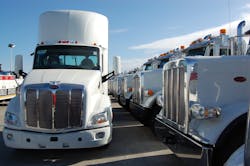Class 8 sales should be flat to moderate in ’13, Rush says
SAN ANTONIO, TX – Retail Class 8 sales in the U.S. should stay flat or rise at most 5% in 2013 compared to this year, according to W.M. “Rusty” Rush, president and CEO of Rush Enterprises, which owns the largest chains of Peterbilt and Navistar dealerships in the nation.
In an interview with reporters here during the company’s annual technician skills rodeo, Rush added that most of those sales should occur in the back-half of next year and total between 190,000 to 210,000 units for 2013.
“I don’t know if we’re ever going to get to the level of sales we had back in 2006,” he pointed out; a record year in the truck sales business, when Class 8 retail sales topped out between 252,792 to 284,008, according to data from Ward’s Communications.
Sales in 2006 resulted from a combination of government regulations of truck emissions and what Rush called an “over-revved economy,” and he doesn’t expect such a set of circumstances to occur like that again.
The company continues to finalize a deal set in motion during the third quarter this year to acquire the assets of a Navistar dealership group in Ohio that sells International, IC Bus, and Isuzu trucks – along with an Idealease franchises – in eight locations, including: Akron, Cincinnati, Cleveland, Columbus, Dayton, Findlay and Lima.
Rush said that Navistar dealership acquisitions – expected to close in early in 2013 – provide a good opportunity to, in his words, expand the ability of the company’s Rush Truck Centers division to serve customers better.
“This acquisition is really customer driven,” he explained to reporters. “We need to keep riding the service side of this business; that’s what our customers are asking us to do and what we’re trying to do. Being in Ohio expands our service footprint; it gives us more ‘dots on the map’ so if a Rush customer is in Ohio, they know we can take care of them.”
Rush also pointed out that Navistar is the number one truck brand in terms of registrations in Ohio, and that oil and natural gas drilling operations are on the increase in the Utica shale region of the Northeastern U.S.; a swath of oil and natural gas rich deposits that underpins a large part of eastern Ohio.
“We do a lot of business with customers working in the shale fields of Texas, Oklahoma, and New Mexico,” Rush said. “So we believe if they’ve liked doing business with us in those states, they may want to do business with us in Ohio.”
He also believes that, despite all the issues Navistar is suffering through in the wake of its abandonment of its Advanced EGR technology strategy for complying with 2010 emission regulations, that company and its truck brands will remain solid contenders in the U.S. market.
“Maybe I haven’t made the return on my investment that I would have liked over the last two years, but Navistar remains a top Class 8 truck brand and a top school bus brand,” he explained. “They’ve been around for 130 years; they’ll get the ship righted.”
About the Author
Sean Kilcarr
Editor in Chief
Sean Kilcarr is a former longtime FleetOwner senior editor who wrote for the publication from 2000 to 2018. He served as editor-in-chief from 2017 to 2018.
